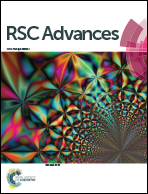Size induced modification of boron structural unit in YBO3: systematic investigation by experimental and theoretical methods†
Abstract
Nanocrystalline YBO3 (∼4–8 nm) was prepared using polyol method. Structural features of these nanoparticles have been investigated jointly by experimental and theoretical methods and compared with corresponding bulk phase of YBO3. The symmetry around Y3+ has been examined by photoluminescence measurements of Eu3+ doped YBO3 sample, while the local structure around boron has been probed through 11B MAS-NMR studies. XRD and photo-luminescence investigations reveal that YBO3 nanoparticles are structurally distorted in comparison to their bulk counterpart. Judd–Ofelt analysis shows that local environment around Y3+/Eu3+ is more polarizable in nanoparticles. 11B MAS-NMR studies confirmed that contrary to bulk phase where only BO4 units are present, nanoparticles of YBO3 have both BO3 and BO4 structural units in almost equal proportion. DFT calculation also predicts the existence of both BO3 and BO4 structural units in YBO3 nanoparticles where BO3 units are primarily distributed on surface of the nanoparticles. We expect that such nanoparticles, rich in unsaturated boron oxides on the surface, will help in the synthesis of inorganic–organic hybrid phosphors for next generation flexible display devices.


 Please wait while we load your content...
Please wait while we load your content...